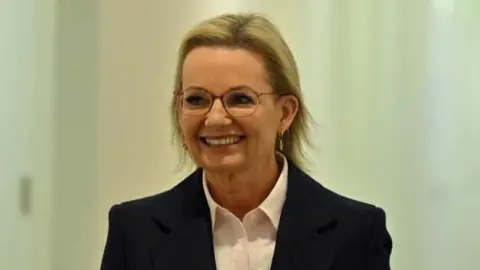Australia’s political landscape has seen significant developments recently, particularly concerning the Liberal-National coalition, which represents the main opposition party in the country. This long-standing partnership has been through many trials over the decades, but the latest news comes as the two parties have agreed to reunite after a brief yet tumultuous split that occurred just a week prior.
The illustration of this political reunion is embodied by Liberal leader Sussan Ley and Nationals leader David Littleproud, both of whom have played crucial roles in negotiating the terms of their alliance. Reports suggest that Ley is set to reveal a new shadow cabinet comprised of members from both parties at a press conference scheduled for Wednesday. This press conference is a highly anticipated event as many observers within political circles are curious to see how the two parties will present a unified front moving forward.
The initial split in the coalition was prompted by fundamental disagreements over key policy issues, which both Ley and Littleproud acknowledged in their statements. Littleproud articulated his dissatisfaction with the inability of the two parties to reach a consensus on pivotal matters, leading to the decision to momentarily part ways. Nevertheless, he also expressed an optimistic desire to rebuild their relationship, indicating a willingness to work collaboratively toward the goal of re-entering a coalition before the next elections.
It’s essential to understand the background of this political scenario. Ley recently took over from former Liberal leader Peter Dutton, who faced considerable criticism following the poor electoral performance of the Coalition. The Labor Party, under the leadership of Anthony Albanese, emerged victorious, winning a second consecutive term in a decisive victory. Ley aims to reposition the Liberals back to the center-right, a crucial step in regaining support from constituents who feel disconnected from the party’s previous direction.
One salient issue that divided the two parties during their recent impasse was their differing outlooks on climate and energy policy, particularly with respect to nuclear power. The Nationals, which traditionally represent regional communities and tend to lean more conservatively than their liberal counterparts, have shown a growing dissatisfaction with the Coalition’s former position. Reports from local broadcaster ABC indicate that the two parties have, in fact, decided to abandon a previous commitment to establish seven nuclear power plants, although they are now contemplating lifting the national ban on nuclear energy altogether. This marks a significant shift in policy dialogue and illustrates the complex nature of negotiating coalition agreements.
Aside from energy concerns, the renewed Coalition is also navigating through other critical policy stances. These encompass infrastructure investments in regional areas, enhancements in internet speeds and mobile coverage for rural communities, and initiatives aimed at bolstering competition within supermarket sectors. By addressing these areas, the Coalition aims to solidify its strategy and appeal to a broader voter base, ensuring that the interests of both metropolitan and regional Australians are met.
Historically, the Liberal-National partnership has seen numerous iterations since its inception in the 1940s, with moments of disbandment and reunion. The last significant split before this recent one occurred nearly forty years ago in 1987. As the two parties attempt to forge a new chapter in their alliance, many will be looking to see if their renewed cooperation can stand the test of time and effectively respond to the contemporary challenges facing Australia. The political path forward remains intricate, but the reopening of dialogue signals a deliberate effort to unify and tackle pressing issues collaboratively.



